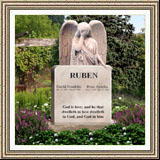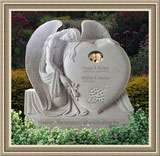|
Cleaning Gravestones, Monuments &
Stone Sculptures
Submitted by Jonathan Appell
One of the most commonly asked questions is, how do I
clean this stone? Although the cleaning of a gravestone
may seem quite simple, this is not always the case.
Every time a historic stone is cleaned, some of the
stones surface is removed in the process. Clean it too
often, and all the inscription and details may be washed
away!
Before any cleaning may begin, it must be determined
what the objective of the proposed cleaning project is.
Most peopleís first desire is to ďrestoreĒ the stone, or
to make it look new again. But, upon further
consideration it may not be desirable to have a new
looking stone in an old graveyard. It is likely to stand
out like a sore thumb!
So what is the driving force behind the desire to clean
gravestones?
One reason is to read an otherwise obscured inscription.
Another reason may be to bring back the beauty of an
otherwise discolored stone or statue. If it looks old,
itís your gut feeling it should be cleaned.
Let us now think in terms of what is best, to promote
the life span of the gravestone, to help preserve it.
Is the stone cleanable?
If the stone shows signs of chipping, scaling, flaking
or other forms of deterioration, do not clean. You will
do more harm then good.
Next, determine what kind of stone is it?
The type of stone can determine what technique should be
used to clean it. Most common gravestones are likely to
be sandstone, slate, marble, limestone, or granite.
Regardless of what kind of stone you are cleaning, the
first rule is always to be as gentle as possible. Use
the least aggressive approach, to accomplish the
cleaning objectives desired; safely without harming the
stone. It may not be possible to clean the stone as
thoroughly as you had hoped before beginning the
project.
Be flexible and relax your preconceived notions
regarding what the stone will look like once the
cleaning operation has been completed.
Always begin with clean water, a soft scrub brush, and
plastic scrapers. Completely saturate the stone to be
cleaned with water.
A pump sprayer works best for most gravestone cleaning
operations. Home centers sell various types with prices
starting as low as $ 10. A sprayer will use much less
water then the old bucket and brush method.
Additionally the bucket method always returns the
polluted water, still on the brush back into the clean
water thus contaminating it.
There are many different types of brushes which work
well for cleaning cemetery memorials. It is best to
always have a wide range of brushes on hand, including
multiple sizes, with various stiffness, of the bristles.
Always begin the cleaning process with the softest brush
to see if it will get the job done. Progress to stiffer
bristles only if needed. Although mentioned previously,
I will repeat, do not use wire or metal brushes of any
kind, as they may scratch damage or stain the stone.
Suggestions regarding brush selection: Some conservators
advise against using natural bristle brushes, as they
may leave behind residue which might increase future
biological growth. In a purest sense this may be true,
and when conserving artifacts in a museum setting, this
may be good advice. Gravestones in an outdoor
environment do not seem to be effected by this extremely
minor, possible residual effect, which natural bristles
pose. On the other hand, natural bristle brushes are
often softer and more effective for many types of stone
cleaning.
Car wash type brushes work well for the softer end of
the spectrum. Do not use old contaminated brushes from
previous non gravestone cleaning projects. Typical scrub
brushes are more aggressive and vary in size and exact
stiffness of the bristles. Grout cleaning brushes are
very effective for getting into tight spaces, such as
cleaning in and around the inscriptions and carvings.
Always remember to rinse often as the cleaning
progresses to monitor for flaking or scaling to the
stone.
I love to use plastic scrapers when ever possible to
remove biological activity. Certain types of growth can
be removed quickly and effectively with only the use of
plastic. They are available from home centers and
hardware stores at a very reasonable price.
Buy the package with a few assorted sizes. Not all
plastic scrapers are formed from the same quality and
hardness of plastic. In many respects the softer the
plastic the better.
Instead of damaging the stone, the plastic wears away
fairly quickly.
Always scrub in a random orbit motion, to avoid
streaking or erosion to the surface of the stone. Many
conservators make an issue to recommend starting the
cleaning operation at the bottom of the stone, working
towards the top. This serves to avoid staining the stone
from runoff as the cleaning advances upward. I have
found that with an average sized gravestone or monument,
it makes little difference where you start cleaning,
provided you clean the entire side once you begin. But,
most importantly be sure to completely rinse off the
stone before it dries. Streaking and staining, may
result if the dirty water is allowed to evaporate before
being rinsed from the stone.
Fred Oakley, one of the founding members of AGS, and
their preservation specialist, asked me if I knew why
the back of a gravestone should always be cleaned first.
He followed up with, if you donít clean it first, you
may not clean it at all, once you have read the
inscription on the front, many people donít want to
spend the time required to finish the job. Funny, but
probably true some of the time.
A non ionic detergent is safe to use on nearly all types
of stones encountered in Cemeteries and graveyards. It
has a neutral PH which will not effect or harm historic
stones. It is sold as a photography product and
distributed by Kodak. It comes in a small plastic
bottle, but you do not need to use much at one time.
Just a once in a gallon or two of water to make a
cleaning solution. A product called Vulpex also will
provide similar results. A word to the wise, donít
expect miracles to occur while cleaning with a non ionic
detergent, you have to be patient as results are often
less then spectacular.
Cathedral Stone Products distributes a product called
D2, which is a biocide. Adapted from the bio-medical
field, it kills the biological growth on stone and
masonry. It has been proven to be very safe and
effective to use on historic stonework of all kinds.
The problem with most cleaning products is they will
only clean on the surface. Just like a tooth, most
biological growth has roots which take hold beneath the
surface. A biocide will not only penetrate the surface
to reach the root structure, but it is the only product
which will inhibit future growth.
A major difference regarding the application of D2 is it
may be sprayed onto a dry stone surface. Within a few
minutes it will go to work eating away at the biological
activity. Be sure to rinse off thoroughly before it
dries, as described above.
One of the drawbacks regarding D2 is it is only sold at
this time via mail order, and I think the smallest size
is one gallon. On the plus side I have never heard of a
shelf life, as it lasts a long time in the bottle. Also
it may be diluted to a weaker strength, and is still
quite effective.
I would like to personally thank Norman Weiss for the
development of D2 and the other stone preservation
products he has helped produce. D2 has become the
product I personally use most of the time for the
cleaning of stone.
Another highly effective cleaning method is to poultice
the stone. This employs the concept a capillary action
to wick away staining safely. A poultice is simply a
clay type substance whish is placed on a pre moistened
stone. The stone is then covered to avoid evaporation.
Once the stone is uncovered, it is rinsed clean of the
poultice and hopefully the staining attempting to be
removed.
This is a very safe technique when properly employed,
and may be performed on very delicate surfaces. It is
often used in museum environments.
Entire books have been published on cleaning stone and
masonry. Historic Scotland has published individual
books for each major kind of stone encountered.
Many web sites have good information on gravestone
cleaning, some of which are included in our Related
Products & Resources Directory. |





